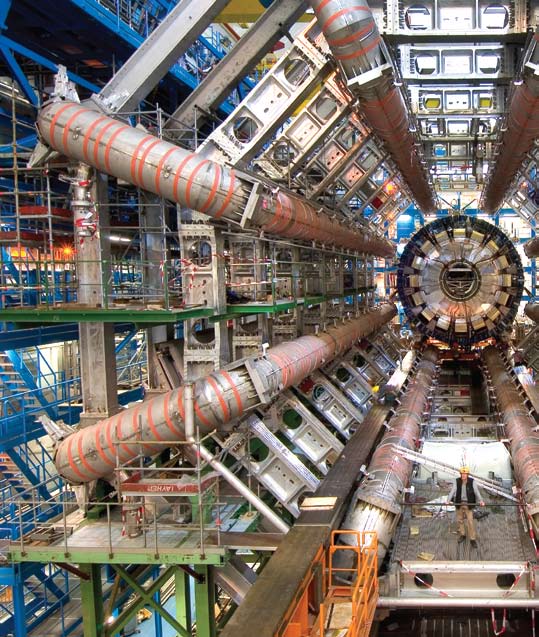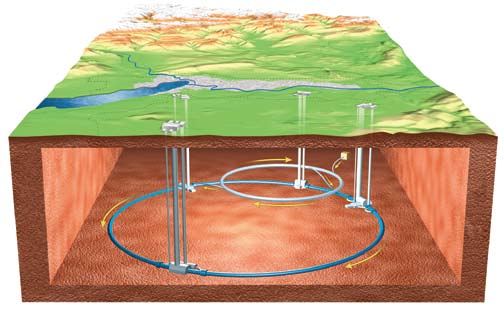by Chrisanne Beckner

Approximately 2,000 international scientists, including a team from the UO, recently took one giant collective leap for mankind when they launched a set of very large experiments that could ultimately answer science's biggest questions:
What happened immediately after the Big Bang? Are there more than three dimensions in space? Is there such a thing as the Higgs boson, otherwise known as the God Particle, which is thought to give everything its mass? And how can science explain the mysterious substance known as dark matter, which can be sensed only through its gravitational effects?
Dark matter "dominates the universe," explained Jim Brau, a UO Knight Professor of Natural Science, "and we don't know what it is." Brau, a particle physicist, believes that a $10 billion lab built more than 100 meters underground will help us find out.
On the border of Switzerland and France, the Large Hadron Collider (LHC) was designed to launch the biggest scientific exploration since the moon landing. But while Neil Armstrong and the Apollo traveled outwards to explore space, the LHC will look inward to understand the still-mysterious forces that created our universe.
Creating Mini Big Bangs
In a controlled environment, the LHC will create mini-Big Bangs, high energy particle collisions that could break apart matter fused together since the beginning of time, potentially revealing particles thus far undetectable. Anticipating the potential for these super high-energy collisions to rewrite the laws of physics, Brau's UO colleagues have devised algorithms that will ensure that the lab's computers capture and analyze the most relevant discoveries -- even though hundreds of millions of collisions happen every second.
Shaped like an enormous 17-mile ring (see illustration below), the LHC is designed to act like a giant racetrack, spinning beams of protons around and around until they reach their highest possible velocity.

When two beams are sent around the loop from opposite directions, traveling at nearly the speed of light, their paths are guided toward contact points where detectors monitor the resulting proton collisions, each of which could potentially produce a Higgs boson, reveal dark matter or show scientists new dimensions in space.
On September 10, 2008, science's unanswerable questions were ready to fall like dominos as the European Organization for Nuclear Research (CERN) powered up the LHC for the first time. However, nine days later, scientists learned that they had controlled for every element of their new particle smasher but one -- temperature.
A Promising Start
The LHC performed better on the first day than most scientists expected. David Strom, a UO physicist and a key player in the way the LHC stores and analyzes data, was there in a large CERN auditorium along with a breathless coalition of elite scientists when the collider went live on September 10. The results were cause for optimism.
As the scientific community watched a large video monitor, they were told to expect a quick flash. That would be the first beam of protons racing around the collider's 17-mile loop before their eyes. The flash came, said Strom, and the room erupted into cheers. This was the first milestone.
Scientists confirmed that the collider could successfully loop particle beams continuously, in both directions, using a series of linked magnets. Those magnets were the key to the collider's success -- and its early breakdown.
To create the high-energy collisions needed to produce a Higgs boson, the magnets within the collider were cooled to about 469 degrees below zero, where they become superconducting. At that temperature, even colder than outer space, magnets have no resistance to electrical current, meaning that the current can be slammed from magnet to magnet, creating a magnetic field that contains and guides the proton beams toward their collision points.
But one of the connectors between the magnets was defective. Nine days after the LHC's launch, the temperature built up at this connector, finally creating an enormous arc that began boiling the helium that was meant to keep the magnets cool. "It basically burst, causing the violent mechanical failure of magnets in that region," said Strom.
According to CERN, the cause of the accident is now understood and steps have been taken to ensure that something like this won't occur again.
Timing "The Trigger"
Since then, the collider has been closed for repairs. It's expected to be back online again this fall. In the meantime, UO's team of particle-smashing physicists continues to work on one of the key elements of the collider's eventual success: choosing which of the billions of future collisions to study.
UO physicists Brau and Strom are working with UO colleagues Ray Frey and Eric Torrence, along with UO's theoretical physicists and a number of lucky grad students, on what's called "the trigger," a combination of hardware and software that manages LHC data.
Strom explained that, with two beams of particles circulating nearly at the speed of light, the collider can generate 600 million collisions per second. Each collision could potentially create a Higgs boson, but no data collection system could save and analyze that much information. If you went to a store, said Strom, and got a truckload of the largest storage disks you could find, the collider could still fill 1,000 of them every second.
To preserve data from only the most relevant collisions, Strom and his team have devised a set of algorithms the computers constantly apply to the data from ongoing collisions. The algorithms help the computers track and analyze only the results scientists most anticipate.
For instance, the hypothetical Higgs boson, if it exists, meets a set of known characteristics related to its mass. If a particle matching its description results from any collision, the LHC will capture the data and store it for scientists to examine. It may discard the data from the other 599,999,999 collisions that happened in the same second.
The challenge is making the trigger work at the same speed as the LHC. "Working in real time is really challenging," said Strom. "If the data's gone, it's gone."
Angels, Demons and Nonsense
Because of the LHC's great potential for discovery, some members of the public view the collider with a combination of awe and fear. For instance, fans of Dan Brown's thriller, Angels & Demons, which is set at CERN's laboratories, wonder if its experiments could get out of control, creating black holes or antimatter that could destroy us all.
"No," said Strom. "Just, no." While scientists do expect the LHC to produce surprising results, maybe even microscopic, harmless black holes, CERN has published studies to prove the LHC is safe, along with supporting quotes from scientists like Steven Hawking, professor of mathematics at Cambridge: "Collisions releasing greater energy occur millions of times a day in the earth's atmosphere and nothing terrible happens. "
"Of course, this is nonsense," said Strom. "Every day, millions of cosmic rays, some just like the ones in our experiments, strike the earth and the moon. As far as I can tell, the moon's still there."
However, there's no way to tell for sure what the world's highest-powered particle collider might produce. The situation is similar, said Brau, to when U.S. scientists first envisioned a particle collider many years ago.
At that time, scientists were asked to explain to Congress precisely what a particle accelerator could accomplish. One pioneering researcher, Edward L. Ginzton, responded, "Senator, if I knew the answer to that question we would not be proposing to build this machine."
Read more about the International Linear Collider that's "The Next Big Thing" in particle physics.



 Watch Darwin talks, read an essay by the "Weird Science" professor.
Watch Darwin talks, read an essay by the "Weird Science" professor.